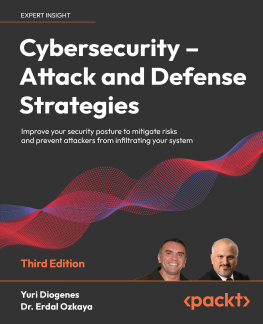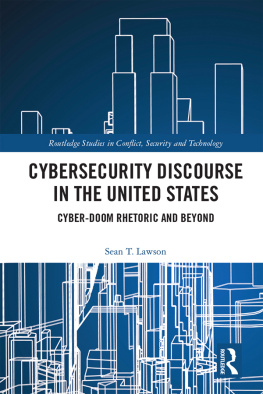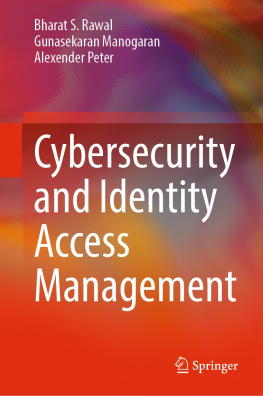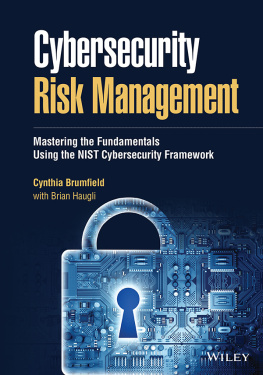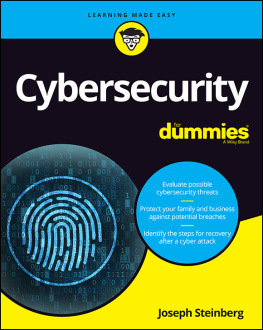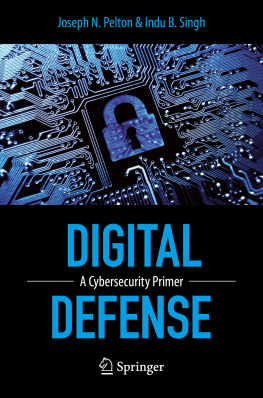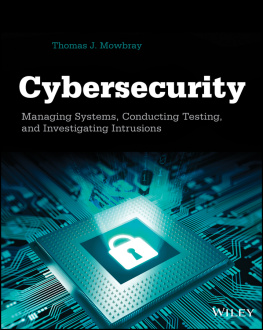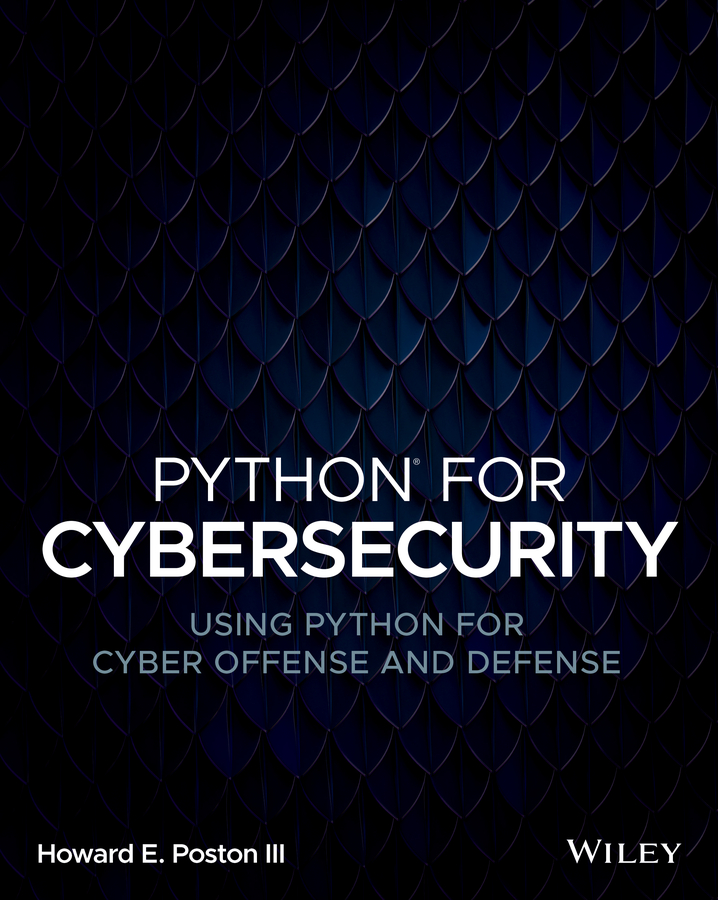
Table of Contents
List of Tables
- Chapter 1
- Chapter 2
- Chapter 6
List of Illustrations
- Chapter 1
- Chapter 2
- Chapter 3
- Chapter 4
- Chapter 5
- Chapter 6
- Chapter 7
- Chapter 8
- Chapter 9
- Chapter 10
- Chapter 11
- Chapter 12
- Chapter 13
Guide
Pages

Python for Cybersecurity
Using Python for Cyber Offense and Defense
Howard E. Poston III

Copyright 2022 by John Wiley & Sons, Inc. All rights reserved.
Published by John Wiley & Sons, Inc., Hoboken, New Jersey.
Published simultaneously in Canada.
978-1-119-85064-9
978-1-119-85070-0 (ebk.)
978-1-119-85065-6 (ebk.)
No part of this publication may be reproduced, stored in a retrieval system, or transmitted in any form or by any means, electronic, mechanical, photocopying, recording, scanning, or otherwise, except as permitted under Section 107 or 108 of the 1976 United States Copyright Act, without either the prior written permission of the Publisher, or authorization through payment of the appropriate per-copy fee to the Copyright Clearance Center, Inc., 222 Rosewood Drive, Danvers, MA 01923, (978) 750-8400, fax (978) 750-4470, or on the web at www.copyright.com. Requests to the Publisher for permission should be addressed to the Permissions Department, John Wiley & Sons, Inc., 111 River Street, Hoboken, NJ 07030, (201) 748-6011, fax (201) 748-6008, or online at http://www.wiley.com/go/permission.
Limit of Liability/Disclaimer of Warranty: The publisher and the author make no representations or warranties with respect to the accuracy or completeness of the contents of this work and specifically disclaim all warranties, including without limitation warranties of fitness for a particular purpose. No warranty may be created or extended by sales or promotional materials. The advice and strategies contained herein may not be suitable for every situation. This work is sold with the understanding that the publisher is not engaged in rendering legal, accounting, or other professional services. If professional assistance is required, the services of a competent professional person should be sought. Neither the publisher nor the author shall be liable for damages arising herefrom. The fact that an organization or Website is referred to in this work as a citation and/or a potential source of further information does not mean that the author or the publisher endorses the information the organization or Website may provide or recommendations it may make. Further, readers should be aware the Internet Websites listed in this work may have changed or disappeared between when this work was written and when it is read.
For general information on our other products and services or for technical support, please contact our Customer Care Department within the United States at (800) 762-2974, outside the United States at (317) 572-3993 or fax (317) 572-4002.
Wiley also publishes its books in a variety of electronic formats. Some content that appears in print may not be available in electronic formats. For more information about Wiley products, visit our web site at www.wiley.com.
Library of Congress Control Number: 2021951037
Trademarks: WILEY and the Wiley logo are trademarks or registered trademarks of John Wiley & Sons, Inc. and/or its affiliates, in the United States and other countries, and may not be used without written permission. Python is a registered trademark of Python Software Foundation. All other trademarks are the property of their respective owners. John Wiley & Sons, Inc. is not associated with any product or vendor mentioned in this book.
Cover image: Alexander/Adobe Stock
Cover design: Wiley/Michael E. Trent
To Rachel
About the Author
Howard E. Poston III is a freelance consultant and content creator with a focus on blockchain and cybersecurity. He has developed and taught more than a dozen courses exploring and explaining various aspects of cybersecurity and has written hundreds of articles on the subject on different outlets. Howard Poston is also the author of several academic articles on security topics, and has spoken on blockchain and cybersecurity at international security conferences.
Acknowledgments
Thanks to my technical editor, Ben Heruska, and the amazing team at Wiley without whom this book would not have been possible.
About the Technical Editor
Benjamin Heruska is a military officer and computer engineer in the United States Air Force, which he joined in 2008. He has diverse military engineering experience across a broad range of computing disciplines, including embedded RF systems development, IT and cybersecurity tool development, software development, vulnerability analysis, cybersecurity incident response, big data engineering and analytics, ICAM development, and technical leadership.
Introduction
This book is all about how to use Python for cybersecurity. Before we dive into that, let's take a moment to talk about the why of Python for cybersecurity.
A good starting point is answering the question Why use automation? If you're already in the cybersecurity field, you probably know that automation is your friend.
If you're just entering the field, consider how hard it is to keep one of your less tech-savvy relatives or friends from installing malware on their phone or falling for a phishing email. Now, scale that up to hundreds or thousands of people. Add in the fact that attackers are actually motivated to target your organization, and a single successful attack could cost the company millions of dollars. Managing cyber risk includes preventing malware infections, detecting and remediating ongoing attacks, ensuring compliance with corporate security policies, and more. By helping to handle some of this for you, automation is your friend.
So, given that automation is necessary in cybersecurity, why use Python? Python has a few features that make it a good choice, including the following:
- It's popular: There's a decent chance that you already know some Python. It's a lot easier to learn new ways to use a language that you know than to learn a new language from scratch. In 2021, Python was the second most popular language on the TIOBE index (
https://www.tiobe.com/tiobe-index/) and was quickly overtaking C. - It's easy: For those of you who don't know Python, it's pretty quick and easy to pick up. This is helpful for both learning and dashing out a program quickly.
- It's powerful: Python has many powerful libraries that can be easily imported into your code. If you want to do anything with network traffic, it's a lot easier to use
scapy than to try to do it from scratch.
How This Book Is Organized
This book is organized based on the MITRE ATT&CK framework. The MITRE ATT&CK framework is a tool produced by the MITRE Corporation to build understanding of how a cyberattack works. It takes the lifecycle of a cyberattack and breaks it into objectives that the attacker may need to achieve on the way to their final goal. For each of these objectives, MITRE ATT&CK describes various ways in which they can be accomplished.
Next page

